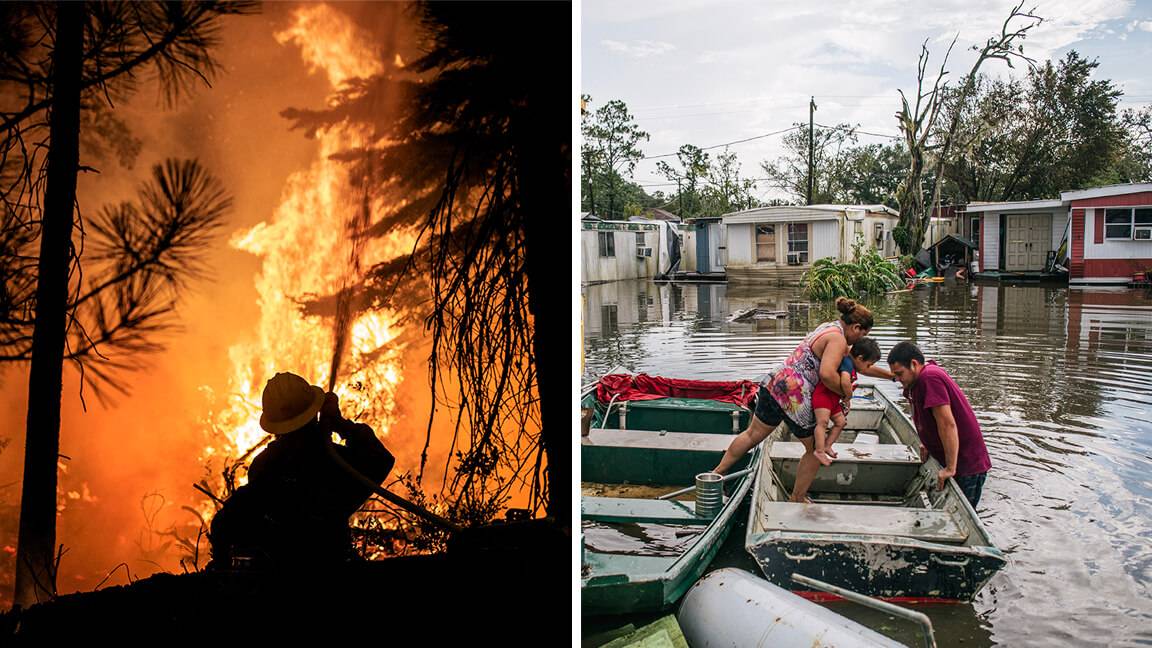In recent years, the frequency and intensity of natural disasters have been on the rise. From devastating hurricanes and wildfires to powerful earthquakes and floods, the world seems to be experiencing more frequent and severe natural calamities. This uptick in natural disasters has led to increased concern and curiosity about the underlying causes. In this detailed SEO-optimized article, we will explore why natural disasters are happening more frequently.
1. Climate Change
a. Global Warming
One of the most significant factors contributing to the increased frequency of natural disasters is climate change. Global warming, driven by the accumulation of greenhouse gases in the atmosphere, is causing the Earth’s average temperature to rise. This warming has several effects:
- Increased Sea Surface Temperatures: Warmer oceans provide more energy for hurricanes and tropical storms, making them more intense.
- Melting Ice Caps and Glaciers: The melting of polar ice contributes to rising sea levels, leading to more frequent and severe coastal flooding.
- Altered Weather Patterns: Higher temperatures affect atmospheric circulation patterns, leading to more extreme weather events such as heatwaves, droughts, and heavy rainfall.
b. Extreme Weather Events
Climate change also leads to more extreme weather events. For instance, warmer temperatures increase the likelihood of heatwaves and exacerbate drought conditions, while altered precipitation patterns can result in heavy rainfall and flooding. These extreme weather events often trigger secondary disasters like landslides and wildfires.
2. Environmental Degradation
a. Deforestation
Deforestation, driven by logging, agriculture, and urban development, plays a significant role in increasing the frequency of natural disasters. Trees and vegetation act as natural barriers against flooding and landslides. When forests are cleared, the land becomes more susceptible to erosion and flooding, especially during heavy rains.
b. Loss of Wetlands
Wetlands serve as natural buffers, absorbing excess water and reducing the impact of storms and floods. The destruction of wetlands due to human activities like construction and drainage for agriculture reduces their ability to mitigate natural disasters, leading to increased flooding and storm surges.
3. Urbanization and Population Growth
a. Increased Vulnerability
Rapid urbanization and population growth have led to the expansion of cities into areas prone to natural disasters. Poorly planned urban development, often in floodplains, coastal areas, and near fault lines, increases the vulnerability of communities to natural disasters. Additionally, the concentration of people and infrastructure in disaster-prone areas exacerbates the impact of these events.
b. Strain on Resources
The growing population puts a strain on natural resources, leading to over-extraction of groundwater, deforestation, and land degradation. These activities destabilize the environment and contribute to the increased occurrence of natural disasters.
4. Geological Factors
a. Tectonic Activity
Earthquakes and volcanic eruptions are primarily caused by tectonic activity. The movement of tectonic plates can trigger seismic events, leading to earthquakes and tsunamis. While the frequency of tectonic activity itself may not have increased, the growing population and urbanization in seismic zones mean that more people are affected when these events occur.
b. Soil Erosion
Human activities like mining, deforestation, and construction can accelerate soil erosion, destabilizing the land and increasing the risk of landslides. Eroded soil can also clog rivers and streams, exacerbating the impact of flooding.
5. Technological and Socioeconomic Factors
a. Improved Monitoring and Reporting
Advancements in technology and communication have improved our ability to monitor, report, and record natural disasters. While this might give the impression that natural disasters are happening more frequently, it is partly due to better detection and documentation.
b. Socioeconomic Vulnerability
Socioeconomic factors such as poverty, lack of infrastructure, and inadequate disaster preparedness and response systems increase the vulnerability of communities to natural disasters. Poor communities often lack the resources to build resilient infrastructure or recover from disasters, making them more susceptible to repeated impacts.
10 Ways to Prevent Natural Disasters
While natural disasters cannot be completely prevented, there are several proactive measures that can significantly reduce their impact and mitigate their effects. By addressing the root causes and enhancing preparedness, we can create more resilient communities. Here are ten effective ways to prevent and reduce the impact of natural disasters:
1. Climate Change Mitigation
a. Reducing Greenhouse Gas Emissions
Lowering greenhouse gas emissions is crucial in combating climate change, which exacerbates the frequency and severity of natural disasters. This can be achieved by:
- Transitioning to renewable energy sources like solar, wind, and hydroelectric power.
- Implementing energy-efficient practices in industries, homes, and transportation.
- Promoting the use of public transportation, carpooling, and electric vehicles.
b. Reforestation and Afforestation
Planting trees and restoring forests help absorb carbon dioxide, reduce soil erosion, and mitigate the effects of climate change. Reforestation projects can stabilize the soil, prevent landslides, and act as windbreaks.
2. Sustainable Land Use Planning
a. Zoning Laws
Implementing strict zoning laws can prevent construction in high-risk areas such as floodplains, coastal zones, and near fault lines. These laws should ensure that buildings are designed to withstand natural disasters.
b. Urban Planning
Proper urban planning involves creating green spaces, improving drainage systems, and ensuring that infrastructure can handle extreme weather events. Sustainable urban development reduces vulnerability to natural disasters.
3. Building Resilient Infrastructure
a. Disaster-Resistant Structures
Constructing buildings and infrastructure that can withstand natural disasters is essential. This includes:
- Using materials and designs that can endure earthquakes, floods, and hurricanes.
- Retrofitting existing buildings to meet current safety standards.
b. Flood Defenses
Building levees, dams, and flood barriers can protect communities from flooding. Additionally, maintaining and upgrading these structures is crucial for long-term effectiveness.
4. Early Warning Systems
a. Weather Monitoring
Investing in advanced weather monitoring and forecasting systems can provide early warnings of impending natural disasters. This allows for timely evacuations and preparations.
b. Communication Networks
Developing robust communication networks ensures that warnings reach all affected individuals, including those in remote or vulnerable areas. Utilizing multiple channels, such as sirens, mobile alerts, and social media, can enhance the reach and effectiveness of warnings.
5. Environmental Conservation
a. Protecting Wetlands and Mangroves
Wetlands and mangroves act as natural buffers against storms and flooding. Protecting and restoring these ecosystems can reduce the impact of natural disasters on coastal areas.
b. Soil Conservation
Implementing soil conservation practices, such as terracing, crop rotation, and contour plowing, can prevent soil erosion and reduce the risk of landslides.
6. Community Education and Preparedness
a. Disaster Drills
Conducting regular disaster drills and simulations helps communities prepare for emergencies. These drills should involve schools, businesses, and households.
b. Public Awareness Campaigns
Raising awareness about natural disaster risks and preparedness measures through public campaigns can empower individuals to take proactive steps to protect themselves and their property.
7. Sustainable Agriculture Practices
a. Crop Diversification
Diversifying crops reduces the risk of total crop failure due to extreme weather events. Planting a variety of crops can enhance resilience to droughts, floods, and pests.
b. Water Management
Implementing efficient irrigation systems and water conservation techniques can mitigate the impact of droughts and prevent soil degradation.
8. Integrated Disaster Management
a. Collaboration and Coordination
Effective disaster management requires collaboration between governments, NGOs, and communities. Establishing integrated disaster management systems ensures a coordinated response to emergencies.
b. Capacity Building
Investing in the training and development of disaster response teams enhances their ability to manage and mitigate the impacts of natural disasters.
9. Financial Instruments
a. Insurance
Encouraging the use of insurance can help individuals and businesses recover from the financial impacts of natural disasters. Governments can also establish disaster relief funds to support affected communities.
b. Incentives for Risk Reduction
Providing financial incentives for adopting disaster-resistant practices and technologies can motivate individuals and organizations to invest in risk reduction.
10. Research and Innovation
a. Scientific Research
Investing in scientific research to understand natural disasters and their underlying causes can lead to better prevention and mitigation strategies. This includes studying climate change, geological activity, and weather patterns.
b. Technological Innovations
Developing and implementing new technologies, such as smart sensors, resilient building materials, and advanced modeling software, can enhance our ability to predict, prevent, and respond to natural disasters.
Conclusion
The increasing frequency of natural disasters can be attributed to a combination of factors, including climate change, environmental degradation, urbanization, geological activity, and improved monitoring. While some of these factors are natural, human activities have significantly amplified their impact. Addressing the root causes, such as reducing greenhouse gas emissions, promoting sustainable land use, and improving disaster preparedness, is crucial to mitigating the frequency and severity of natural disasters in the future.
I am Komal Hatwaani, aims to provide readers with informative and engaging content that covers everything from technology and business to entertainment and lifestyle. This website dedicated to delivering high-quality content that informs, entertains, and inspires our readers.
Join us on our journey as we continue to explore the ever-evolving landscape of news and information, providing you with valuable insights and perspectives that enrich your digital experience.













